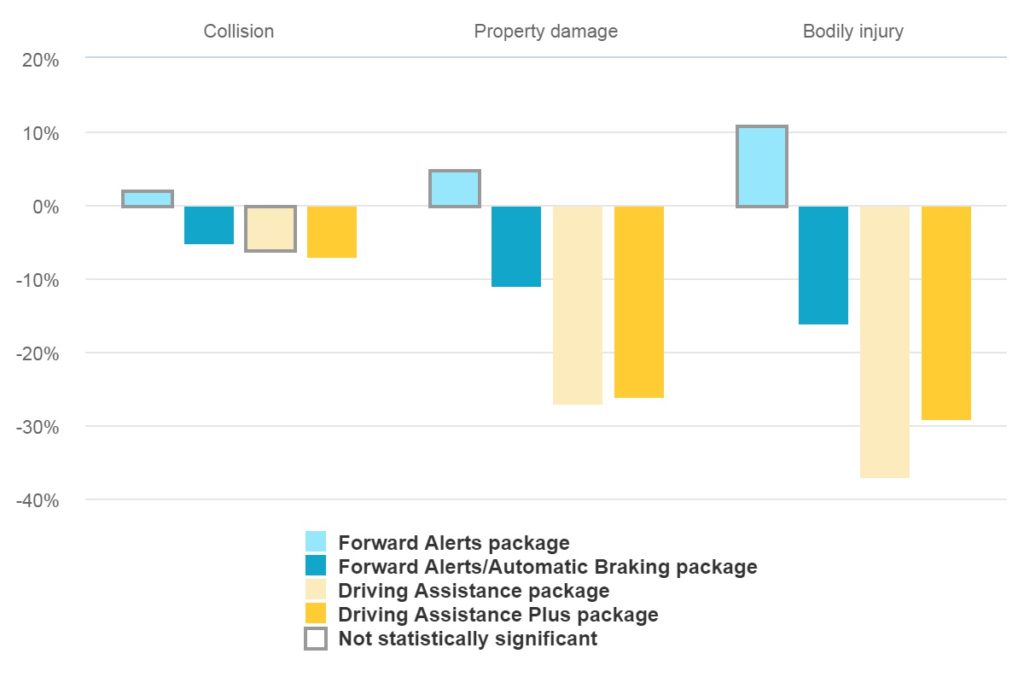
IIHS: BMW ADAS cuts collision, property damage claims
By onEducation | Market Trends | Technology
Three out of four advanced driver assistance systems packages studied led to reductions in auto claims for 2013-17 BMWs, new IIHS Highway Loss Data Institute research has found.
The BMW Forward Alerts package included lane departure and forward collision warnings, but the car wouldn’t actually take action itself to head off a crash. The Forward Alerts/Automatic Braking package added autobraking to the mix, and the Driving Assistance Package included adaptive cruise control on top of all of that. The Driving Assistance Plus package incorporated all of these features as well as front cross-traffic warnings and lane centering.
The Driving Assistance package of forward collision and lane departure warnings, autobraking and adaptive cruise control cut property damage claims 27 percent and bodily injury claims 37 percent, the Insurance Institute for Highway Safety reported Thursday. Collision claims fell as well, though the 6 percent reduction found wasn’t deep enough to be statistically significant.
The OEM’s Driving Assistance Plus suite produced similar results despite its additional ADAS, according to the IIHS.
The Forward Alerts/Automatic Braking package containing less advanced versions of forward collision warning, lane departure warning and autobraking reduced property damage claims 11 percent, bodily injury claims 16 percent and collision claims 5 percent. All three were statistically significant.
The study captured about 30,000 “insured vehicle years” each for Driving Assistance and Forward Alerts. The Forward Alerts/Autobraking package represented about 550,000 insured vehicle years, while Driving Assistance Plus covered about 120,000 insured vehicle years.
“The large exposure of Driving Assistance Plus makes this study by far the broadest examination of the impact of systems that combine speed control with lane centering on insurance losses,” the IIHS wrote.
“The crash claim frequency reductions for BMW’s Driving Assistance package are the largest we’ve seen from advanced driver assistance systems, which suggests crash avoidance may be delivering bigger benefits as the technology improves,” HLDI Senior Vice President Matt Moore said in a statement. “The lane centering that comes in the ‘plus’ package doesn’t seem to augment these benefits. That may be because the system is only intended for use on freeways, which are comparatively safer than other roads, and only works when the driver switches it on.”
The Forward Alerts combo of collision and lane departure alerts actually increased collision claims 2 percent, boosted property damage claims 5 percent and increased bodily injury claims 11 percent. But repairers shouldn’t read too much into this result. “None of these results was statistically significant, and they differed from HLDI’s studies of similar systems from other manufacturers,” the IIHS wrote.
Overall, the BMW data suggests the kind of volume drops repairers might encounter as ADAS spreads throughout the U.S. fleet.
It’s possible severity could also fall. The larger reductions seen in bodily injury liability claims compared to property damage liability claims suggest that ADAS might be slowing vehicles enough that crashes aren’t bad enough to hurt occupants. Of course, this might also slow vehicles enough to keep some crashes from becoming totals, which could help with volume.
The study also explained the technology behind the various ADAS features. The HLDI’s descriptions suggest what additional components repairers might find have incurred damage or require calibration:
Forward collision warning (FCW) uses sensors in the front bumper and a video camera to monitor traffic in front of the vehicle, and can recognize vehicles that are in the detection range of the sensors and video camera. …
Automatic emergency braking (AEB) … is controlled by a video camera in the area of the rearview mirror and can provide braking intervention at city speeds. On some vehicles the system is controlled by a radar sensor in conjunction with the camera, which provides braking intervention at both city and highway speeds.
Active cruise control (ACC) is a system that uses radar sensors (or the existing camera hardware in some vehicles) to monitor traffic ahead and maintain the driver’s selected following distance or speed.
Front cross-traffic alert (FCTA) … The vehicle detects objects approaching the vehicle and will warn the driver with visual and acoustic signals. …
Lane departure warning (LDW) uses a camera embedded in the rearview mirror to detect painted lines in the road. …
Lane-steering assistant (LSA) … A multitude of radar sensors and a stereo camera monitor the vehicle environment and transmit signals to a control unit, a stereo camera responsible for lane and object recognition, a front-radar sensor and four side-radar sensors for vehicle environment monitoring.
More information:
“Benefits from advanced driver assistance systems are growing, new HLDI study finds”
Insurance Institute for Highway Safety, April 16, 2020
“2013–17 BMW collision avoidance features”
Highway Loss Data Institute, December 2019
Featured image: Three out of four advanced driver assistance systems packages studied led to reductions in auto claims for 2013-17 BMWs, new IIHS Highway Loss Data Institute research has found. (Provided by Insurance Institute for Highway Safety)

